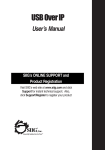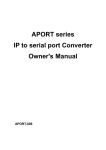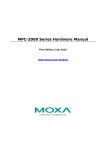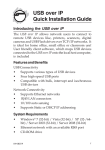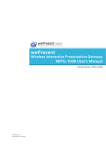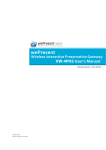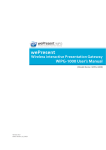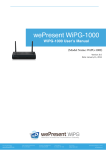Download SIIG USB Over IP User`s manual
Transcript
USB Over IP User User’’s Manual SIIG’ T and SIIG’ss ONLINE SUPPOR SUPPORT Product Registration Visit SIIG’s web site atwww.siig.com and click Support for instant technical support. Also, clickSupport/Register to register your product About SIIG, Inc. Founded in 1985, SIIG, Inc. is a leading computer upgrade manufacturer of I/O connectivity products, including PCI & ISA serial and parallel ports, USB, Serial ATA & UltraATA controllers, FireWire (1394a/b), networking, sound cards, and other accessories. SIIG is the premier one-stop source of upgrades. SIIG products offer comprehensive user manuals, many userfriendly features, and are backed by an extensive manufacturer warranty. High-quality control standards are evident by the overall ease of installation and compatibility of our products, as well as one of the lowest defective return rates in the industry. SIIG products can be found in computer retail stores, mail order catalogs, through major distributors, system integrators, and VARs in the Americas and the UK, and through e-commerce sites. PRODUCT NAME USB Over IP FCC RULES: TESTED TO COMPLY WITH FCC PART 15, CLASS B OPERATING ENVIRONMENT: FOR HOME OR OFFICE USE FCC COMPLIANCE STATEMENT: This device complies with part 15 of the FCC Rules. Operation is subject to the following two conditions: (1) This device may not cause harmful interference, and (2) this device must accept any interference received, including interference that may cause undesired operation. THE PARTY RESPONSIBLE FOR PRODUCT COMPLIANCE SIIG, Inc. 6078 Stewart Avenue Fremont, CA 94538-3152, USA USB Over IP is a trademark of SIIG, Inc. SIIG and the SIIG logo are registered trademarks of SIIG, Inc. Microsoft, Windows and Windows Vista are either registered trademarks or trademarks of Microsoft Corporation in the United States and/or other countries. Other names used in this publication are for identification only and may be trademarks of their respective companies. March, 2008 Copyright © 2008 by SIIG, Inc. All rights reserved. User's Manual Contents Chapter 1: Introduction 1-1 Unpacking the USB Over IP ................................................. 1-1 1-1.1 Static Electricity Precaution ............................. 1-2 1-1.2 Record the Serial Number ................................ 1-2 1-2 Introducing the USB Over IP .............................................. 1-3 1-2.1 Features and Benefits ........................................ 1-3 1-2.2 System Requirements ....................................... 1-4 1-2.3 Layout ................................................................. 1-4 Chapter 2: Hardware Installation and Device Compatibility 2-1 Hardware Installation .......................................................... 2-1 2-2 Device Connection ................................................................ 2-1 2-3 USB Device Support.............................................................. 2-2 2-3.1 USB Device Interoperability List .................... 2-2 Chapter 3: Driver Installation 3-1 Driver Installation ................................................................. 3-1 3-1.1 Windows XP Installation ................................. 3-1 3-1.2 Windows Server 2003 Installation .................. 3-6 3-1.3 Windows Vista Installation ........................... 3-11 3-2 To Verify Installation .......................................................... 3-18 3-2.1 Windows XP/Server 2003 ............................. 3-18 3-2.2 Windows Vista ................................................ 3-18 3-3 Set IP Address ...................................................................... 3-19 ii Contents Chapter 4: USB Over IP Admin 4-1 Introducing the USB Over IP Admin ................................. 4-1 4-2 Windows Vista Firewall ....................................................... 4-2 4-3 Using USB Over IP Admin .................................................. 4-3 4-3.1 Quick Start Icon .................................................. 4-3 4-3.2 USB Devices ........................................................ 4-3 4-3.2.1 USB Function Buttons .......................... 4-4 4-3.3 Servers Screen .................................................... 4-4 4-3.3.1 Servers Function Buttons .................... 4-5 4-4 How To's ............................................................................... 4-6 4-4.1 Device Mapping ................................................ 4-6 4-4.1.1 How to Connect .................................... 4-6 4-4.1.2 How to Disconnect ............................... 4-7 4-4.1.3 Printer Auto Connct ............................. 4-8 4-4.2 Server Manager ................................................. 4-9 4-4.2.1 Setup (Server Configuration) ............. 4-9 4-4.2.2 Unlock and Reset Password ............. 4-11 4-4.2.3 Refresh (Refresh Servers) .................. 4-14 4-4.2.4 Restore (Restore Factory Settings) ... 4-15 4-4.2.5 Upgrade (Upgrade Firmware) ......... 4-17 4-4.2.6 Configure IP Address ........................ 4-18 Chapter 5: Technical Support and RMA 5-1 Overview ............................................................................... 5-1 5-2 Technical Support and RMA ............................................... 5-2 iii User's Manual About This Manual The purpose of this manual is to introduce you to your USB Over IP server. It will guide you to properly configure and install into your system. Please save this manual for future reference. This manual is comprised of the following sections: Chapter 1: Introduction Provides unpacking instructions, and introduces features and specifications. Chapter 2: Hardware Installation and Device Compatibility General overview to connect install your adapter. Chapter 3: Driver Installation Describes how to install the drivers to your operating system. Chapter 4: USB Over IP Admin Describes how to configure and use your product. Chapter 5: Technical Support and RMA Provides instructions on how to obtain technical support or return a product in the event of a problem. iv Introduction Chapter 1 Introduction Thank you for your purchase of the USB Over IP. SIIG’s goal is to provide reliable, high quality products and fast customer support. The purpose of this comprehensive user’s manual is to: • Introduce you to your USB Over IP features and benefits • Guide you through the steps for an easy, trouble-free installation in your system • Provide technical support information in the event of a problem. Before installing the board, please review this chapter for unpacking instructions and an overview of the key features. Then refer to later chapters for installation instructions. 1-1 Unpacking the USB Over IP Before installing the adapter, verify that the following items are included in the packaging carton: • • • • USB Over IP adapter Power Adapter Driver CD This User's Manual Please contact your dealer if any item is damaged or missing. 1-1 User's Manual 1-1.1 Static Electricity Precaution One of the routine precautions you must be aware of when working with computer components is the problem of static electricity discharge. Note: Leave the product in its anti-static bag until you are ready to install it. Caution: Static electricity discharge may permanently damage your system. In order to avoid possible static electricity discharge during installation procedures, please follow the guidelines below: • • Discharge any static electricity build up in your body by touching a large grounded metal surface or the computer case (if plugged in), for a few seconds. During installation procedures, avoid any contact with internal parts. Handle cards only by their edges. 1-1.2 Record the Serial Number In order for SIIG's Technical Support or RMA Department to give you prompt service, you will need the following product information. The serial number label is located on the side of the box and on the adapter. Please take a moment to record the serial and part number. Serial Number: Part Number: Date purchased: 1-2 Introduction 1-2 Introducing the USB Over IP The USB Over IP allows network users to connect remote USB devices like, printers, scanners, digital cameras and USB Flash drives over the network. It is ideal for home office, small office or classroom use! User friendly client software, which maps USB devices connected to the USB Over IP onto the local host computer, is included 1-2.1 Features and Benefits USB Connectivity • Supports various types of USB devices • Four high-speed USB ports • Compatible with bulk, interrupt and isochronous USB devices Network Connectivity • Supports Ethernet networks • RJ45 LAN connectors • 10/100 auto sensing • Supports Static or DHCP IP addressing Client Software • Supports various types of USB Traffic (Control, Bulk, Interrupt and Isochronous) • Designed to comply with Microsoft WHQL Unclassified software category tests • Support both Ethernet and Wi-Fi networks • User-friendly application interface • Device mapping feature for adding and removing USB devices • Printer auto connect feature 1-3 User's Manual 1-2.2 System Requirements • Windows® XP (32-/64-bit)/Server 2003 (32-/64bit)/Vista (32-bit) Ethernet network with an available RJ45 port CD-ROM drive • • 1-2.3 Layout Ready LED Power LED Power LED: USB Over IP is powered on Ready LED: when the box is first powered on, the USB Over IP goes through it's initialization/bootup sequence. The LED will blink for 10 seconds, then it will go off for 10-15 seconds, initialization is successful when the LED comes back on. If the Ready LED ever goes off, power-off then power-on the USB Over IP. It is recommended to unplug all devices from the USB Over IP during it's initialization/bootup sequence. • • Ethernet Port 1-4 USB Ports Power Adapter Jack USB IP Admin Software Utility Chapter 2 Hardware Installation and Device Compatibility 2-1 Hardware Installation General hardware installation instructions are provided below. Since the design of computer cases and motherboards vary, refer to your computer's reference manual for further information, if needed. Static Electricity Discharge may permanently damage your system. Discharge any static electricity build up in your body by touching your computer case for a few seconds. 1. 2. 3. 4. Connect one end of your Ethernet cable to the Ethernet Port of the USB Over IP. Connect the other end of the Ethernet cable to an available RJ45 port on your Ethernet switch or hub. Plug the power adapter into the USB Over IP, then plug the power adapter into a reliable power source. Wait for the USB Over IP to complete it's initialization/bootup sequence and the Ready LED to light up before proceeding to the next section. 2-2 Device Connection The USB Over IP supports up to four USB devices. Connect your USB device(s) to any port on the USB Over IP. The green LED will light to show successful connection. 2-1 User's Manual 2-3 USB Device Support USB Over IP Admin client software is based on open architecture, wherein the USB Over IP box virtualizes the connected USB devices onto the remote client. The Client, installed on the remote host, interacts with the USB Over IP box and enables remote access. In this approach, device drivers of the connected USB device are installed on the remote host only, as if the device is connected to it's USB ports. 2-3.1 USB Device Interoperability List The following USB devices were tested in Windows XP SP2 32-bit operating system in default setup mode. Device Type Make Prolific Serial and Parallel Networking FTDI USB to 4-port Serial MCS7840 USB to 4-port Serial MCS7820 USB to 2-port Serial MCS7720 USB to 2-port Serial MCS7830 USB to 10/100 Adapter Belkin Hubs Phone 2-2 Model PL2303 Hub Hub D-Link Hub i-Rocks Hub Enter Hub Skype USB Audio Device YAP USB Audio Device TV Tuner Diamond Multimedia Wireless Belkin PVR660 USB to 802.11G USB IP Admin Software Utility 2-3.1 Device Interoperability List Contd. Device Type Webcam Make Logitech Quickcam Messenger Logitech Quickcam Easy Logitech Quickcam Go Logitech Quickcam Pro 3000 Logitech Quickcam Pro 4000 Logitech Quick Communicate STX Microsoft LifeCam VX-1000 Microsoft LifeCam VX-3000 Creative Vista Plus Webcam Quantum QHMPL 500lm-8lm Frontech e-CAM Microsoft LifeCam VX-6000 Logitech Quickcam for Notebooks Pro Sony Speakers Microsoft Turtle Beach Multimedia Model SIIG Sony USB Speakers Microsoft Life Chat LX3000 head phones Audio Advantage Micro Sound Card USB SoundWave 7.1 USB SoundWave 7.1 Pro 2-3 User's Manual 2-3.1 Device Interoperability List Contd. Device Type Make Acer Keyboard Mouse Joystick Mass Storage Device Mac Extended Keyboard Microsoft Comfort curve keyboard Microsoft Intranet Pro Keyboard Apple Apple Optical mouse Apple Apple mouse Microsoft Microsoft Basic mouse Logitech Logitech mouse Sun Sun mouse Dell Dell mouse IBM IBM mouse Microsoft Joystick Iomega USB Zip 100 Toshiba Transmemory Kingston DataTraveler DTI 1GB Kingston DataTraveler MiniFun DTMFP/2GB SanDisk Cruzer Micro 1GB SuperTalent Super Flash Drive 2GB Western Digital HDD Enclosure WD600 U017 - 60GB Go Transcend 2GB ZipSys 2-4 Acer Keyboard Apple Mac ViPower DVD Model NEC Pocket Drive VP-2528 JF V30 USB to IDE controller DVD ROM USB IP Admin Software Utility 2-3.1 Device Interoperability List Contd. Device Type Make Model Business InkJet 1200 DeskJet D2360 HP LaserJet 1020 (GDI printer) DeskJet 3740 PhotoSmart 3200 LaserJet 2200d Printers EPL-6200L Epson Stylus C87 Plus Stylus C58 Plus LX-300 +II Canon Samsung WeP iP1700 ML 1210 Bloom Laser 1600+ OfficeJet 4315 All-in-One DeskJet F380 All-in-One HP Multi-function printers PhotoSmart C6188 All-in-One PhotoSmart C3100 All-in-One Canon MP160 MFP Brother MFC-9700 Multi Function Dell Scanners LaserJet 3200 HP All-in-One Printer 946 ScanJet 1300C ScanJet 4470C 2-5 Driver Installation Chapter 3 Driver Installation 3-1 Driver Installation This section provides information on how to install the USB Over IP drivers. 3-1.1 Windows XP 1. 2. 3. 4. Connect the USB Over IP to your network and boot up Windows. At the Windows desktop insert the driver CD. Autorun should start the installation, if not, click Start, then Run. Type D:\Launch.exe then click OK. (Change D: to match your CD-ROM drive letter) At the USB Over IP screen click Install. 3-1 User's Manual 5. At Choose Components, click Next. 6. At Choose Installation Location, click Install. 3-2 Driver Installation 7. At the Security Alert, click Yes. (skip this step for 32-bit XP) 8. At Completed, click Finish. 3-3 User's Manual 9. At the Found New Hardware Wizard, select No, not this time, click Next. (skip this step if not prompted) 10. Windows detects a new device, at the Found New Hardware Wizard, select Install the software automatically (Recommended), click Next. 3-4 Driver Installation 11. At the Security Alert, click Yes. (skip this step for 32-bit XP) 12. Click Finish. 3-5 User's Manual 13. At Windows Security Alert, click Unblock. (skip this step for 32-bit XP) 14. Repeat steps 9-12 for each USB Over IP connected to your network. Restart XP to complete the installation. 15. 3-1.2 Windows Server 2003 1. 2. 3. 3-6 Connect the USB Over IP to your network and boot up Windows. At the Windows desktop insert the driver CD. Autorun should start the installation, if not, click Start, then Run. Type D:\Launch.exe then click OK. (Change D: to match your CD-ROM drive letter) Driver Installation 4. At the USB Over IP screen, click Install. 5. At Choose Components, click Next. 3-7 User's Manual 6. At Choose Install Location, click Install. 7. At Security Alert, click Yes. 3-8 Driver Installation 8. Click Finish. 9. At the Found New Hardware Wizard, select No, not this time, then click Next. 3-9 User's Manual 10. Select Install the software automatically (Recommended), click Next. 11. At Security Alert, click Yes. 3-10 Driver Installation 12. Click Finish. 13. Repeat steps 9-12 for each USB Over IP connected to your network. 3-1.3 Windows Vista™ 1. 2. Connect the USB Over IP to your network and boot up Windows. At the Windows desktop insert the driver CD. At the Auto Play window: click Open folder to view files. 3-11 User's Manual 3. 4. 3-12 If Auto Play doesn't start: click Start, in the Start Search box, type D:\Launch.exe. (Change D: to match your CD-ROM drive letter) Right click Launch, click Run as administrator. Click Allow. At the USB Over IP screen, click Install. Driver Installation 5. At Choose Components, click Next. 6. At Choose Install Location, click Install. 3-13 User's Manual 7. At Windows Security, click Install this driver software anyway two times. 8. Click Finish. 3-14 Driver Installation 9. At Windows FireWall Security Alert, click Unblock. 10. Right click the USB Over IP Admin icon located on the desktop, click Properties. 3-15 User's Manual 11. Click Compatibility tab. Check Run this program as an administrator, click OK. (This step may take up to 30 seconds to complete) 12. Click Start, All Programs, USB Over IP. 3-16 Driver Installation 13. Right click the USB Over IP Admin icon, click Properties. 14. Click Compatibility tab, check Run this program as an administrator, click OK. 3-17 User's Manual 3-2 To Verify Installation 3-2.1 Windows XP/Server 2003 1. 2. 3. Right click My Computer, click Manage, click Device Manager. Double click USBoIP Device Servers. Virtual USB Bus should be displayed for each USB Over IP connected to the network. 3-2.2 Windows Vista 1. 2. 3. 3-18 Right click Computer, click Manage, click Continue. Click Device Manager, double click USBoIP Device Servers. Virtual USB Bus should be displayed for each USB Over IP connected to the network. Driver Installation 3-3 Set IP Address The factory default IP address given to the USB Over IP is 192.168.3.22. This address may not match your network's subnet address, in this case, your USB devices will not be detected by the USB Over IP Admin. This section guides you through setting the IP address to match the subnet mask of your network. 1. At the SIIG USB Over IP screen, click Configure. Note: You must have Administrator rights to run this utility in Windows Vista. 3-19 User's Manual 2. Click Unblock. (Skip this step if not prompted) 3. At List of Servers, double click the MAC address of the USB Over IP you want to change. 3-20 Driver Installation 4. At IP Configuration screen, either type in the IP address, subnet mask, and gateway or select DHCP, then click Change. 5. Click Exit to save and exit. 3-21 Configuration Utility Chapter 4 USB Over IP Admin 4-1 Introducing the USB Over IP Admin The USB Over IP Admin is a user friendly PC software which supports High speed USB cameras, USB audio, USB Printers, Multi-function printers, scanners, storage devices, PDAs, digital cameras, serial adapters, mice, keyboards and much much more. • • • • • • • • • Supports various types of USB Devices (class, multifunction and vendor specific) Supports all types of USB traffic (control, bulk, interrupt and isochronous) Designed to comply with Microsoft WHQL Unclassified software category tests Server Manager with search and display servers on network Supports both Ethernet and Wi-Fi networks Supports USB device safe removal User friendly application interface Device mapping feature for adding and removing USB devices Printer auto connect feature 4-1 User's Manual 4-2 Windows Vista FireWall Windows Vista operating system firewall blocks the USB Over IP Admin Quick Start Icon from starting up automatically at boot up. Follow the steps below to enable it. 1. After Windows Vista has fully started, click on the Blocked startup programs icon located in the taskbar by the system clock. 2. Place the mouse cursor over Run blocked program, then click USB Over IP Admin Application. Click Allow. Note: Follow these steps each time Windows Vista is booted up or restarted. 4-2 Configuration Utility 4-3 Using the USB Over IP Admin The USB over IP Admin is used to connect to your USB devices and configure your USB Over IP server. 4-3.1 Quick Start Icon The USB Over IP Admin Quick Start Icon installs automatically during driver installation and is located on the right side of the taskbar by the system clock. Double click the icon to open the USB Over IP Admin. 4-3.2 USB Devices The USB Devices window is divided into two sections, Device Mapping and Device Details. Device Mapping shows all detected USB devices, Device Details shows information about the USB device. 4-3 User's Manual 4-3.2.1 USB Function Buttons • • • • Refresh: refreshes USB device list Connect: connects to a free USB device Disconnect: disconnects from a connected USB device Printer Auto Connect: automatically connects and disconnect to your printer when a print job is sent 4-3.3 Servers Screen The Server screen is divided into three sections, Server Manager, Server Details and Connected Clients (IP:USBPort). • • • 4-4 Server Manager: displays all USB Over IP servers connected to the network Server Details: displays basic USB Over IP server information Connected Clients: displays the client IP address and device's USB port of each client connected to the server Configuration Utility 4-3.3.1 Server Function Buttons • • • • • Refresh: searches for servers Unlock: unlocks password enabled servers Upgrade: upgrades server firmware Setup: enters Server Configuration. This button is disabled whenever a server is password enabled Restore: restores the box to its factory default IP settings of 192.168.3.22 4-5 User's Manual 4-4 How To's 4-4.1 Device Mapping 4-4.1.1 How to Connect 1. In the Device Mapping window, select a device who's status is Free, then click the Connect button. 2. The Status will change to Connected. 3. Depending on the device, Windows will either automatically install a driver for it or prompt you for a driver. Read the device's user's manual for driver installation instructions, if needed. 4-6 Configuration Utility 4-4.1.2 How to Disconnect 1. In the Device Mapping window, select a device who's status is Connected, then click the Disconnect button. 2. The Status will change to Unloading then to Free. 4-7 User's Manual 4-4.1.3 Printer Auto Connect The Printer Auto Connect feature automatically connects and disconnects your printer from your computer everytime you send a print job to the printer. Make sure the printer driver has been installed and the printer is configured to print from your computer before enabling this feature. Make sure you are disconnected from the printer before continuing, see section 4-4.1.2 on page 4-7 on how to disconnect. 1. 2. 3. Click the Printer auto connect button. Select the check box next to the printer's name. Click Save. Note: Only printers that have been setup and configured properly to print from your computer will show up on the printer list. Check in Windows Printers icon in Control Panel for proper installation. Consult your printer's users manual for more information, if needed. 4-8 Configuration Utility 4-4.2 Server Manager 4-4.2.1 Setup (Server Configuration) Use the Setup button to change server name, modify IP settings and enable or disable password. If the server is password protected the setup button will be disabled. To enable the Setup button, go to section 4-4.2.2 Unlock Server and Reset Password. 1. 2. In Server Manager, click the server that you want to configure. Click the Setup button. 3. Select Basic Settings tab, modify the server name. 4-9 User's Manual 4. Select IP Settings tab. Check Modify, then either select Static and type in your IP address and gateway or, to have your server configured automatically, select DHCP. 5. Select Password tab. Check Modify, then enable, disable or change your password. 6. Click Save to save your changes and exit. 4-10 Configuration Utility 4-4.2.2 Unlock Server and Reset the Password Whenever the USB Over IP is password protected, it's Status will be Locked. Follow the steps in the order that they appear to unlock the server. 1. Select the locked server and click the Unlock button. 2. Type in your current password, and click OK. 4-11 User's Manual 3. Your password will be confirmed or denied, click OK. If failed, try again. If you continue to have problems, check with your system administrator for the correct password. 4. Click Refresh button, the server status should be Unlocked. Click the Setup button. 4-12 Configuration Utility 5. Select the Password tab. 6. Check Modify, uncheck Enable Password, then click Save. 4-13 User's Manual 4-4.2.3 Refresh (Refresh Servers) 1. Click the Refresh button. 2. The Searching for Servers box will pop up. 4-14 Configuration Utility 3. The Server Manager list will be refreshed. 4-4.2.4 Restore (Restore Factory Default Settings) The factory default settings are: SIIG (Server Name), 192.168.3.22 (IP) and 192.168.3.1 (Gateway). 1. Click the Restore button. 4-15 User's Manual 2. Click OK. 3. Click OK. 4. Click Refresh to display the server list. 4-16 Configuration Utility 4-4.2.5 Upgrade (Upgrade Firmware) 1. Select a server, click the Upgrade button. 2. In Select File box, browse to or type in the location of the file, then click Transfer. Do not unplug the power adapter from the USB Over IP during the update process. 4-17 User's Manual 4-4.2.6 Configure IP Address: Server Not On the Same Subnet 1. At the Server Manger screen, select the server that is not on the same subnet. 2. At Configure IP Address, click Yes. 4-18 Configuration Utility 3. Click Unblock. (Skip this step if not prompted) 4. Either type in an IP address and Gateway or select DHCP, then click Change. 4-19 User's Manual 5. 4-20 At the Server Manager screen, click Refresh. Yes should be displayed in the Same Subnet? column of the server. Technical Support & Product Return Chapter 5 Technical Support & RMA 5-1 Overview This chapter will give you instructions on how to obtain product information, contact technical support and return defective product. This user's manual is written with easy-to-understand instructions on how to configure and install this product in your system. We encourage you to consult this manual as your first step for technical assistance. There are several steps you can take should you find problems with this product. It is most helpful if you consult the following resources: 1. 2. 3. Installation instructions from this user's manual Technical Support Warranty & RMA Information 5-1 User's Manual 5-2 Technical Support and Warranty QUESTIONS? SIIG’s Online Support has answers! Simply visit our web site at www.siig.com and click Support. Our online support database is updated daily with new drivers and solutions. Answers to your questions could be just a few clicks away. You can also submit questions online and a technical support analysts will promptly respond. SIIG offers a lifetime manufacturer warranty with this product. Please see our web site for more warranty details. If you encounter any problems with this product, please follow the procedures below. A) If it is within the store's return policy period, please return the product to the store where you purchased from. B) If your purchase has passed the store's return policy period, please follow these steps to have the product repaired or replaced. Step 1: Submit your RMA request. Go to www.siig.com, click Support, then RMA to submit a request to SIIG RMA. If the product is determined to be defective, an RMA number will be issued. SIIG RMA department can also be reached at (510) 413-5333. Step 2: After obtaining an RMA number, ship the product. • Properly pack the product for shipping. All software, cable(s) and any other accessories that came with the original package must be included. • Clearly write your RMA number on the top of the returned package. SIIG will refuse to accept any shipping package, and will not be responsible for a product returned without an RMA number posted on the outside of the shipping carton. • You are responsible for the cost of shipping. Ship the product to the following address: SIIG, Inc. 6078 Stewart Avenue Fremont, CA 94538-3152, USA RMA #: • SIIG will ship the repaired or replaced product via Ground in the U.S. and International Economy outside of the U.S. at no cost to the customer. 5-2 Technical Support & Product Return Blank Page 5-3 User's Manual Blank Page 5-4 03-0315A




























































